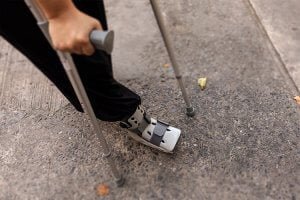- Sticks, Canes & Crutches
- Our Quality Guarantee
- Last Updated November 30, 2025

How To Walk With a Cane Correctly (for Safety and Stability)
If you are having difficulties with your mobility resulting from knee surgery, injury, or other conditions, you might have considered using a cane. When used safely and correctly, a cane is a perfect companion in providing stability and balance to people who require additional control and flexibility while walking. They can go a long way towards reducing pain and providing support and balance to those who need them. However, while they undoubtedly have many benefits, new users often wonder: How do I use a cane properly?
In short, to use a cane properly, you should first hold the cane on the side of your “good” leg (the opposite leg to the one that needs support). Then, when walking on level ground, you should move the cane forward in unison with your “bad” leg, placing weight on it as necessary.
When correctly used, the right cane can significantly improve your steadiness and reduce your likelihood of falling. It does this by widening your support base and easing the pressure on your lower body.
Of course, the above-outlined answer is only a short one, so here’s a detailed guide on how to use a cane properly to maintain balance while walking:
In This Article
Select the Correct Cane for Your Needs
Any cane you use should match your needs and fit you correctly. So, before you begin searching for a cane, it’s essential to figure out how much assistance you’ll need from it and even whether you need it.
Do you Need a Walking Stick or Cane?
In short, you’ll know it’s time to start using a walking cane when a medical evaluation supports that decision. More specifically, a cane can benefit those who require improved balance and stability or experience joint pain while walking.
Of course, everyone’s body and circumstances are different. Athletes with temporary injuries and elderly individuals with balance issues, for instance, have different needs when using a walking cane.
That said, here are some common situations where using a walking cane can be beneficial:
9 Signs It Is Time to Use a Walking Cane
1. Joint Pain:
If you feel extreme joint and knee pain while walking, consult a healthcare professional for proper diagnosis and treatment. A cane may be recommended to help alleviate this pain. However, other mobility aids like wheelchairs or walkers might also be advised, depending on your condition.
2. Back Pain:
Experiencing back pain often results in poor posture. A medical evaluation is necessary for proper treatment. Concurrently, a cane may be recommended to prevent further issues.
3. Injury:
Consult a healthcare provider for proper treatment if you’ve broken or sprained your ankles or knees. Using a cane can alleviate pressure on the injured area but doesn’t necessarily speed up healing.
4. Doctor’s Recommendation:
Adhere to your healthcare provider’s recommendation regarding cane use. Some conditions may require long-term or even permanent use of a cane, so don’t discontinue its use solely based on personal feelings.
5. You Need Assistance When Walking:
A cane can provide more independence if you constantly hold onto someone or objects such as furniture.
6. Tiredness:
Feeling out of breath or abnormally tired after walking may indicate underlying health issues. You can consult a healthcare provider for a proper diagnosis. A cane may be one part of a broader treatment plan.
7. Old Age:
Mobility issues can accompany aging, but only sometimes. Older adults should consult healthcare providers for tailored advice. A cane can help improve stability and comfort, but isn’t a given for everyone.
8. Instability:
Fears of falling can be alleviated with a walking cane, but it’s not a one-size-fits-all solution. A healthcare provider can recommend the best mobility aid for you.
9. Flights of Staircases or Uneven Ground:
For challenging terrains like staircases or uneven ground, specialized canes may be necessary. You can consult a healthcare provider for the best type of cane for your needs.
Contraindications for Using a Walking Cane
Not everyone should use a walking cane, and there are specific scenarios and medical conditions where using one might not be the best course of action. Here’s a breakdown:
Medical Conditions Where a Cane May Not Be Advisable:
- Severe Upper Body Weakness: Using a cane might be impractical or unsafe if you have significant weakness in your arms or hands. Alternative mobility aids or treatments may be more appropriate.
- Cognitive Impairments: Individuals with severe cognitive issues, such as advanced dementia, may be unable to use a cane safely or effectively.
- Certain Neurological Conditions: In some cases, neurological conditions like advanced Parkinson’s disease may make it difficult to use a cane properly, and other options like walkers might be more appropriate.
- Unstable Fractures or Severe Injuries: A cane may not provide adequate support for more severe conditions. Consult your healthcare provider for the best mobility aid for your situation.
Situational Considerations:
- Walking on Slippery or Uneven Surfaces: Some canes are not designed for all terrains. Specialized canes or other mobility aids may be needed.
- Multi-Tasking: A cane might not be suitable if you need to carry items or perform tasks requiring both hands. Walkers with storage or other hands-free mobility aids could be better options.
- Long-Distance Walking: A cane might need more support or comfort for extensive walking. Wheelchairs or motorized scooters could be more appropriate for longer distances.
- Climbing Stairs: While a cane can help on stairs to some extent, those with significant mobility issues may find stair-specific devices or elevators safer.
The decision to use a walking cane should be based on a medical evaluation tailored to individual needs. While canes can relieve various situations, such as joint pain, back pain, and instability, they are part of a broader healthcare strategy and not a substitute for professional medical advice.
Factors to Consider while Choosing the Cane
Generally, selecting the cane that best suits your needs is dependent on two factors:
1. Type of Cane
There are many different types and styles of walking canes available on the market to help remedy your functional mobility problems. These include quad canes, forearm canes, and adjustable canes. The features to consider when choosing the right kind of cane include:
Grip
While selecting a grip depends on personal preferences, consider choosing a grip that’s shaped to fit your hand. A good grip will help you relieve unnecessary stress and avoid joint pain.
Shaft
The shaft is the long and central body of the cane. You want a shaft that is sturdy and reliable. While some shafts are foldable, they are often less robust, so this is something to look out for.
Ferrule.
The ferrule is the cap, often made from rubber, that covers the tip of a cane to ensure stability and support while walking and prevent slipping. You want to ensure the ferrule of your cane is suitable for the surfaces you intend to use it on. It’s also worth noting that some canes come with a single ferrule while others can have up to four (i.e., a quad cane/4-prong-cane).
2. Length of the Cane
To ensure safety and mobility, you want a cane that will let you walk freely without having to lean or bend your body. In effect – your cane’s length needs to be suitable for your height. While the perfect height will differ from person to person, the typical suggested length of a cane is about half the height of the user.
Here is how to properly fit your cane:
- Wear regular walking shoes and stand upright.
- Relax your arms and bend your elbow at a comfortable angle of around 15-25 degrees. If you intend to use your cane primarily for balance, consider bending your elbow slightly more for extra stability.
- Measure the distance from your wrist joint to the ground. This distance should be around the length of your cane.
Thankfully, most modern canes are adjustable and let you set the preferred length of the cane to meet your specific needs – but always check the product descriptions before assuming this!
Using Your Walking Cane Properly
After choosing the cane that matches your needs, learning how to use it correctly while walking is essential. Before using their cane for the first time, most users expect it to be simple – but in reality, it isn’t as simple as you’d expect:
It would be best if you generally held your cane on the opposite side of your injury, besides your “good” leg, to provide enough support to the injured leg. This will ensure you have adequate support and balance your “bad” leg when stepping forward.
While we explain below the best way to use a cane properly, the video might be better for you. We attach the following video by physical therapists Bob Schrupp and Brad Heineck for your reference:
When Walking On Level Surfaces
- When walking on level surfaces, move the cane while taking a step forward with your weak or injured leg simultaneously. Every time you take a step with your “good” leg, keep your cane in place.
- While doing this, always place most of your weight on the “good” side of your body. This will ensure your injured limb has as much support as possible.
- Please note that you should always use your “good” leg for your first full-weight step and then move the cane about a steps-distance while taking a step with your “bad” leg.
When Walking Up Stairs
- When using your cane to ascend stairs, place one hand on the handrail (if available) and keep your cane in your other hand.
- Holding onto the rail, advance one step forward with the “good” leg and then move your injured leg up to the same step.
- If there is no handrail on the stairs, advance one step forward with your “good” leg, then place the cane on the same step while moving your bad leg forwards.
Which Side Do You Use a Cane On?
You should generally use a cane on the opposite side of your injured leg or knee. Using a cane on the opposite side of the injury would be best because it is more efficient and reduces discomfort. Using a cane in this way allows you to maintain stability when walking and relieves stress from your injured side.
Mistakes to Avoid When Using A Cane
When using a cane to assist with walking, people make some common mistakes. It’s essential to avoid these because instead of improving your condition, they might complicate it:
- Don’t use a cane that is not ideal for your height.
- Don’t hold a cane with the wrong hand while walking; you should always hold a cane on the opposite side to the injury.
- Don’t place your cane too far ahead while walking; this may cause you to stretch unnecessarily.
- Don’t use a cane excessively, this may lead to hand or should pain.
- Don’t use a cane if you don’t need one, a walking stick might be a better alternative.
With all these considerations in mind, we are sure your experience using a cane should be smooth and without issue. Whether a short-term injury or a long-term condition, we know that using a cane correctly is a great way to alleviate functional mobility issues.
Articles You May be Interested In:



















